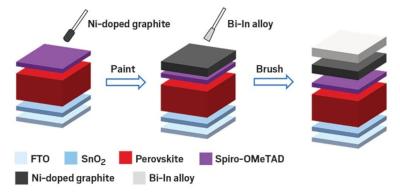Researchers design hole-transporting bilayer that helps achieve efficient, stable, and fully printed carbon-electrode perovskite solar cells
Printable planar carbon electrodes are emerging as a promising replacement for thermally evaporated metals as the rear contact for perovskite solar cells (PSCs). However, the power conversion efficiencies (PCEs) of the state-of-the-art carbon-electrode PSC (c-PSC) noticeably lag behind their metal-electrode counterparts. Recently, researchers from Friedrich-Alexander-Universität Erlangen-Nürnberg have proposed a hole-transporting bilayer (HTbL) configuration to improve the fill factor and the open-circuit voltage of carbon electrode PSCs (c-PSCs).
The HTbL was prepared by sequentially blade coating two organic semiconductors between perovskite and carbon, with the outer HTL enhancing hole extraction to carbon, while the inner HTL mitigates perovskite surface recombination. Consequently, the fully printed c-PSCs with HTbL outperformed those with single HTL, and a stabilized champion PCE of 19.2% was achieved compared with that of 17.3%.







